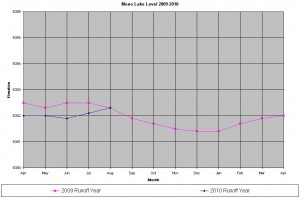
It has been an unusual summer for water. With just 104% of average runoff forecasted for the Mono Basin, sudden warmth the first week in June brought peak flows down the creeks more typical of a wet year. But despite the high flows in the creeks during June and July, the total volume is not representative of a wetter year.
Grant Lake Reservoir spilled from July 3rd until the 31st, but this week the flows in almost all the creeks have rapidly declined, bringing an end to the spill. Water export through the Mono Craters Tunnel resumed on July 22nd and is currently flowing at 40 cfs, which should add up to LADWP’s maximum allowed export of 16,000 acre-feet by March 31st.
Mono Lake’s elevation peaked this year in mid-July at around 6382.32 feet above sea level, and then dropped to today’s level of 6382.27, with 4/5ths of that drop occurring in the last four days. It has finally caught up to 2009 and matched the August 1, 2009 level.

So despite high peak flows in the streams, 2010 runoff has been just enough to fill up Grant Lake Reservoir, allow LADWP its permitted amount of water export, and keep Mono Lake at the same elevation as last year. Just over 100% of average runoff would be expected to do this. But August 2010 runoff may exceed August 2009–it is too early to tell. If Mono Lake doesn’t drop this August and September as much as it did last year, which I think is likely, it will end up with a net rise for the 2010 water year ending September 30th. This would be the first time it has had an annual rise since the wet year of 2006–something worth celebrating!
